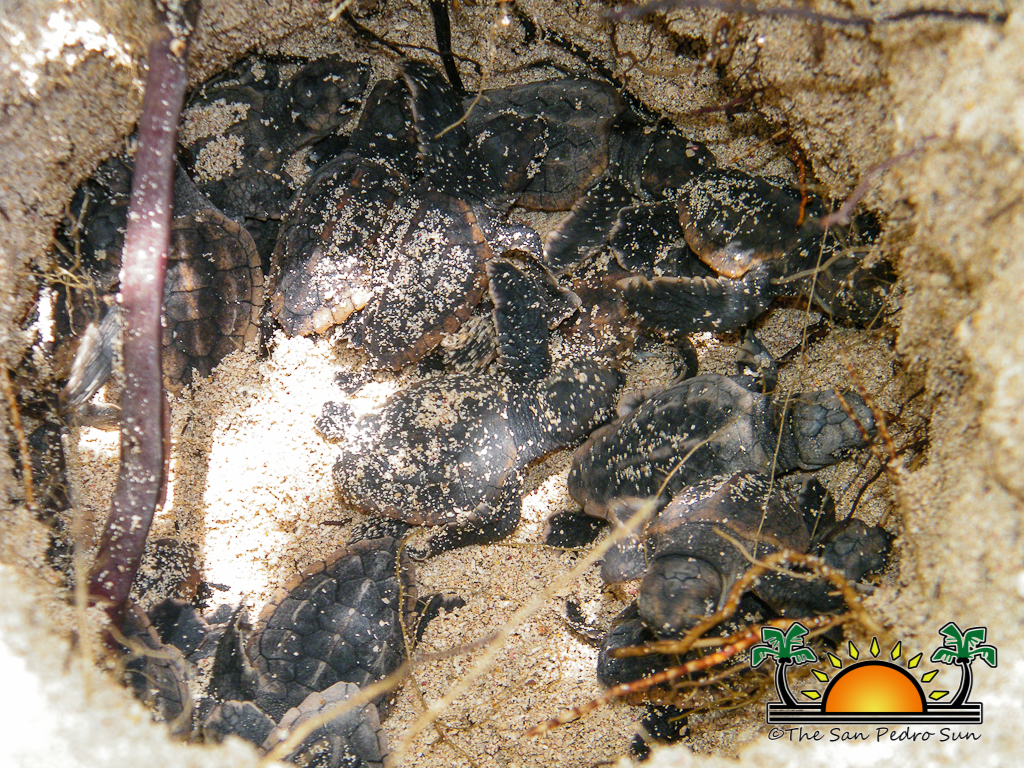The 2017 turtle nesting season is fast approaching, and soon, the female sea turtles will lay their eggs throughout Ambergris Caye’s nesting grounds. Nesting season lasts from May to September, and conservationists at Hol Chan Marine Reserve are working arduously to help preserve the turtle’s laying grounds.
According to Hol Chan biologist Kirah Forman Castillo, sea turtle populations are declining throughout the world. “For those sea turtle species that call Belize home, the International Union for Conservation of Nature (IUCN) Red List has registered loggerhead turtles as being vulnerable, green turtles as endangered, and hawksbill turtle as critically endangered,” said Forman Castillo.
In 2016, the Ambergris Caye Marine Turtle Program (ACMTP), managed by Hol Chan, recorded a total of 89 nests, which is 20% less than in 2015. Although nest counts naturally fluctuate annually, the average number for the past five years has been 82 nests per season. However, due to Hurricane Earl, only 40 of the 89 nests were hatched in 2016. Hurricane Earl made landfall during the first week of August, the peak time for hatching of loggerheads and nesting for green turtles. Around 49 nests (55%) of the laid nests were lost. The remaining 3,792 eggs (45%) were allowed to incubate, of which 58% hatched, and most of those 51% (1,918 eggs) emerged from the nest unaided.
The nesting population in Ambergris Caye is the largest known and studied nesting population of loggerhead and green turtles in Belize. While loggerheads and green turtles are the main species that utilizes the beaches of Ambergris Caye for nesting, hawksbills occasionally visit. In 2016, four nests were confirmed to be of the hawksbill. ACMTP states that Rocky Point and Robles Beaches continue to be the key nesting areas. In 2016, 54 nests were laid at Robles, 24 at Rocky Point, five at Basil Jones, two in the Punta Azul area, and four nests were randomly laid in other areas, including one found in the Tres Cocos area.
How to Help Protect Nest Sites
Although turtles can withstand the effects of natural disasters, human impact is more of a threat to population declines. Therefore, Hol Chan states that the public can help save the country’s threatened and endangered sea turtles.
According to Hol Chan, the nesting beaches of Ambergris are mostly threatened by expanding tourism development. “The entire Ambergris Caye was historically known as a nesting site, however, even in the past, the nesting was concentrated in the north due to the close proximity of the reef to the beach. The increase in tourism development moving further north has resulted in the increase of vehicular traffic along the beaches (even at Robles), improperly placed beach lighting, seawalls, and docks,” said Forman Castillo.
Sea turtles rely on specific beaches for nesting, and are particularly vulnerable to habitat alteration. Hol Chan said that there has been no mitigation measures enforced during the nesting season to reduce these negative impacts. Thus, people’s actions on the beach can determine whether our loggerhead, hawksbill, and green sea turtles nest successfully.
Residents/visitors are advised to: safeguard nesting females and their hatchlings for the duration of the season; properly dispose of the debris abandoned on the beach; refrain from making sand castles or leaving behind any objects that may hinder the turtle’s access to and from the ocean; and to not illuminate areas near the beach. Artificial light from beachfront homes, streetlights and even flashlights can attract the hatchlings away from the safety of the water and lead them to their deaths.
The recreational use of areas such as Robles on the weekends has also become a concern to Hol Chan. “Nesting on the beach does not mean that the beach cannot be used. It just means that people need to be more aware, and adjust their use of the area during the nesting season, and pick up their garbage. Nesting sites are critical to the survival of the sea turtles. These charismatic creatures not only fill important ecological roles, but also they are an essential part of Belize’s tourism identity,” said Forman Castillo.
ACMTP will continue to monitor the beaches, and look at ways to address threats to ensure Ambergris Caye continues to be used as nesting sites. As for the 2017 nesting season, Hol Chan stated that it is difficult to predict what it will be like. A single female will only return to nest every two to three years, and lay multiple clutches (nests) per season, which can cause natural fluctuations in the total number of nestslaid each year.
In Belize, sea turtles have been a protected species since 1993, and the disturbing of turtle nests or possession of sea turtles is illegal. The selling or trafficking of any sea turtle can constitute an infraction that can result in a fine of up to $1,000 and up to one year’s imprisonment. You can help sea turtles by reporting those that are sick, injured, entangled or dead. You can also report all suspected nests or sea turtle crawls during nesting season to the Hol Chan Marine Reserve office at 226-2247.


